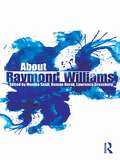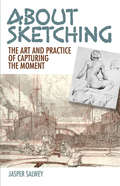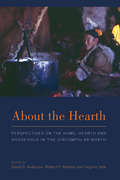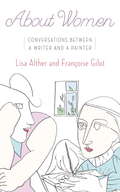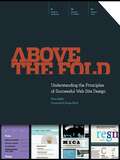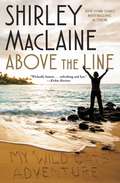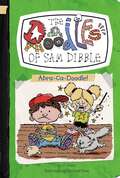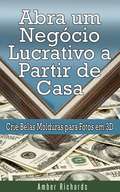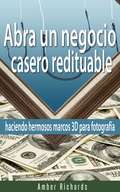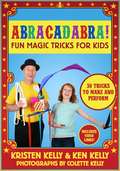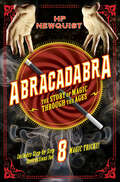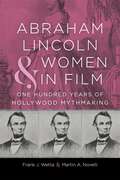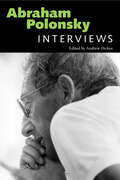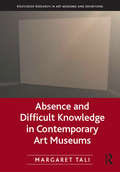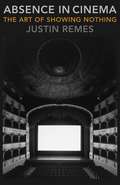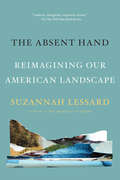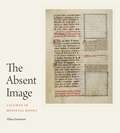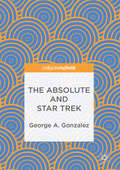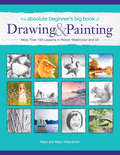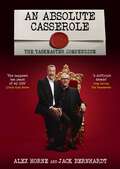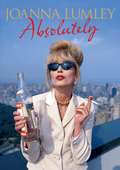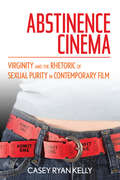- Table View
- List View
About Raymond Williams
by Monika Seidl Roman Horak Lawrence GrossbergAbout Raymond Williams represents the overdue critical acclaim of Williams’ lasting influence and unbroken repercussions in critical thought. His writings have effectively shaped the ways in which people understand the complexity of the notion of 'culture' and many of the ways it has been taken up in scholarly practice.
About Sketching: The Art and Practice of Capturing the Moment
by Jasper Salwey Leonard SquirrellWritten as a sketching artist's companion, this guide by a noted author of art instruction manuals attests to the value of sketching as a distinct art form rather than merely a vehicle to achieve more polished works. Artist and author Jasper Salwey details advantages of many drawing media, from pencil to watercolor, and their application to depictions of interior studies, figures, landscapes, seascapes, and architecture.Suitable for artists and students of moderate to advanced skills, the book makes a case for why the artist needs to sketch and the importance of sketching to the history of art. Salwey's advice and insights are illustrated by relevant examples that range from works by the Old Masters to those of his great contemporaries, including Frank Brangwyn, Dame Laura Knight, and John Singer Sargent.
About the Hearth
by David G. Anderson Virginie Vate Robert P. WishartDue to changing climates and demographics, questions of policy in the circumpolar north have focused attention on the very structures that people call home. Dwellings lie at the heart of many forms of negotiation. Based on years of in-depth research, this book presents and analyzes how the people of the circumpolar regions conceive, build, memorialize, and live in their dwellings. This book seeks to set a new standard for interdisciplinary work within the humanities and social sciences and includes anthropological work on vernacular architecture, environmental anthropology, household archaeology and demographics.
About Women
by Francoise Gilot Lisa AltherA provocative and wide-ranging conversation between two distinctive women--one American and one French--on the dilemmas, rewards, and demands of womanhood.Lisa Alther and Françoise Gilot have been friends for more than twenty-five years. Although from different backgrounds (Gilot from cosmopolitan Paris, Alther from small-town Tennessee) and different generations, they found they have a great deal in common as women who managed to support themselves with careers in the arts while simultaneously balancing the obligations of work and parenthood. About Women is their extended conversation in which they talk about everything important to them: their childhoods, the impact of war on their lives and their work, and their views on love, style, self-invention, feminism, and child rearing. They also discuss the creative impulse and the importance of art as they ponder what it means to be a woman.From the Hardcover edition.
Above the Fold: Understanding the Principles of Successful Web Site Design
by Brian MillerThis is a different kind of web design book. Above the Fold is not about timely design or technology trends; instead, this book is about the timeless fundamentals of effective communication within the context of web design. It is intended to help you, the reader, understand the considerations that web designers make when developing successful websites.Above the Fold is divided into three sections:Design & TypographyPlanning & UsabilityBusiness Value Each section represents a phase in the continuous cycle of web design. It's the balance among design, usability, and return on investment that makes a website truly great.Topics covered in Above the Fold include:What makes web design uniqueThe history of web designAnatomy of a web pageWhite space and grid use in web designThe elements of web design: color, texture, imagery, scale, depth, animation, and variabilityWeb typography, including web-safe type, images of type, and font replacement and embeddingWeb project planningInformation architecture, including site maps, wireframes, and user flow diagramsThe elements of usability: navigation, breadcrumbs, links, search, submission forms, and error messagingSearch engine optimizationOnline marketing, including banner ads, viral and social marketing, on-site marketing, and email marketingWeb statistics and analysis
Above the Fold, Revised Edition
by Brian D MillerAbove the Fold is a book about the fundamentals of clear graphic communication within the context of Web design. The book has three sections, which follow the cycle of a typical Web project:PLAN Section I focuses on the predesign phase of a Web project. From project planning and brief writing to information architecture and responsive grid creation.DESIGN The second section of Above the Fold explores the enduring principles of design and the nuances that are specific to the field of Web design.OPTIMIZE Finally, we close the loop and discover ways to enable your client to maximize the investment they've made in their Web site with marketing and analytics.
Above the Line: My Wild Oats Adventure
by Shirley MacLaineA funny, fierce, imaginative memoir chronicling New York Times bestselling author and Academy Award winner Shirley MacLaine’s remarkable experiences filming Wild Oats in the Canary Islands and the extraordinary memories her time there brought forth of a past life on the lost continent of Atlantis.Her agent advised her not to get on the plane. The male leads weren’t even cast. The financing was shaky at best. The script had been rewritten countless times. And yet something about Wild Oats lured Shirley MacLaine to the film’s location shoot in the far-off Canary Islands—and straight to the center of one of the most thrilling and paradigm-shifting adventures of her life. The making of the film reads like a screwball comedy, as the cast and crew face unpredictable daily obstacles with ingenuity, grit, and personal sacrifice. Yet the chaos leads Shirley to a revelatory new understanding of the demise of one of history’s most elusive yet endlessly intriguing places. Scholars have long theorized that Spain’s Canary Islands are the remnants of the mighty lost continent of Atlantis. As the movie set descends into pandemonium, Shirley finds fascinating corollaries between the island’s cataclysmic fate and our own dangerous trajectory. Can we learn the lessons the citizens of Atlantis failed to comprehend? The answer is borne out of recovered memories from Shirley’s past life on Atlantis and through a series of meditations that reveal the necessity of unfettered imagination when looking for bold new truths, rendering this evocative, irreverent, and honest memoir essential reading for anyone seeking a broader understanding of what it means to be human—both where we came from and where we are going.
Above Victoria and Vancouver Island
by Russ Heinl Gillian BirchABOVE VICTORIA AND VANCOUVER ISLAND is a stunning collection of 105 aerial photographs of Vancouver Island, BC taken by renowned photographer, Russ Heinl. This high-quality ebook offers a series of breathtaking images, capturing aerial views of Vancouver Island's spectacular landscapes in precise detail. Heinl's diverse subjects range from the ivy-covered Empress Hotel in Victoria to surfers riding world-class surf at Tofino and Long Beach. Those who enjoy British Columbia's great outdoors will appreciate these awe-inspiring aerial views of Vancouver Island's magnificent snow-capped peaks of Mount Washington and Strathcona Provincial Park. Nature lovers will pore over the images of Grey Whales, right down to the barnacles on their tail fins as the whales complete their annual migration along the coast of Vancouver Island, celebrated by thousands attending the Pacific Rim Whale Festival. See "The Snowbirds" flying in formation over Vancouver Island, seals basking on rocky offshore islets and a host of magnificent coastal views captured in this stunning ebook of aerial photographs. Chapters feature Tofino, Long Beach and the Pacific Rim National Park, Port Hardy and Cape Scott, the scenic waterfront at Nanaimo, Victoria, the elegant capital city of British Columbia and its suburbs of Sidney and Sooke. Using the latest gyro-stabilized Nikon camera systems these stunning views of the earth from the air show Vancouver Island at its very best. From the open door of the helicopter, aerial photographer Russ Heinl has captured the charismatic splendour and remote natural beauty of Vancouver Island, its cities, mountains, beaches and wildlife. Enjoy these aerial views time and time again with this beautiful photography ebook of Victoria and Vancouver Island.
Abra-Ca-Doodle! #4 (The Doodles of Sam Dibble #4)
by J. PressSam's school is hosting a talent show to raise money for the Environmental Center. But Sam doesn't have a talent to perform! Or so he thinks. He tries juggling, but just can't get the hang of it. Plus, his arch-nemesis, Wax, decides to juggle in the talent show as well--and Wax is good. But in a moment of inspiration, Sam learns that sometimes you don't have to look very far to find out what you're really good at!
Abra um Negócio Lucrativo a Partir de Casa
by Amber Richards Isabel Maria P. BarbosaClassificação de 5 estrelas para uma ideia criativa de criação de um negócio a partir de casa Neste E-book irá aprender a iniciar um negócio a partir de casa criando bonitas molduras para fotos em 3D. As molduras em 3D são molduras para fotos criadas de forma única e contêm vários tipos de enfeites aplicados com o objetivo de criar uma obra de arte que expõe fotos com singular beleza. É um olhar sobre as opções envolvidas, quer seja criar as molduras como um hobby, iniciar negócio a partir de casa ou abrir uma loja física comum. O livro analisa os aspetos de criação das suas molduras enfeitadas de forma original, como desenhar e conceber os seus projetos e até fazer o marketing do seu produto final. Contudo, o principal foco é o aspeto criativo deste tipo de negócio. Existem muitas razões pelas quais as pessoas procuram ter um negócio a partir de casa e o livro sublinha alguns dos motivos e dos benefícios. Está fora do âmbito de aplicação do livro analisar em demasia os impostos, se devemos ou não fazer incorporações, obter capital de arranque, aconselhamento jurídico ou consultoria contabilística, fazer pesquisa de mercado e criar um plano de negócio, pois estes tópicos podem ser extensos e implicam a leitura de livros inteiros. Existem, contudo, recursos listados para ajudar os leitores a escolherem a direção certa para juntar mais dados sobre os tópicos mencionados acima, antes de prosseguirem. As diligências preliminares são necessárias se deseja iniciar algum negócio. Se procura um possível negócio a partir de casa, este é uma boa leitura para ajudá-lo a decidir se deve ou não seguir este caminho.
Abra un negocio casero redituable haciendo hermosos marcos 3D para fotografía
by Amber Richards Carlos M. OchoaEste libro indaga la posibilidad de abrir un negocio casero de hacer bellos marcos 3D para fotografías. Los marcos 3D son de diseño único, marcos para fotos con varias formas de adornos utilizados para crear una obra de arte, que muestra a las fotografías de manera hermosa. Es un vistazo a las opciones disponibles, ya sea a nivel de un pasatiempo, un negocio casero, una tienda regular, o un almacén. Profundiza en el aspecto de que usted haga sus propios marcos para fotografía con adornos, diseñe sus proyectos, e incluso comercialice su producto terminado. El enfoque principal esta sobre el aspecto creativo de este tipo de negocios. Hay muchas razones por las cuáles la gente busca tener un negocio casero, y se centra en algunas de las razones y beneficios. Queda fuera del rango de este libro indagar acerca de los impuestos, incorporarse o no, obtener el capital inicial, obtener asesoría legal o contable, la investigación de mercado, o crear un plan de negocios, pues cada uno de estos asuntos puede llegar a ser muy extenso y merecería un libro por sí mismo. Sin embargo, hay recursos enumerados para orientar a los lectores en la dirección correcta para que pueda reunir más información de los temas mencionados, antes de que proceda. Se requiere de la preparación adecuada cuando se considera abrir un negocio. Si usted está buscando un posible negocio casero, esta es una buena lectura para considerar esta opción.
Abracadabra!: Fun Magic Tricks for Kids - 30 tricks to make and perform (includes video links)
by Kristen Kelly Ken Kelly Colette Kelly100% 5-star reviews don’t lie: this is the "best choice": "a lot of pictures", "links to videos", "we can do ALL tricks with stuff we already have", 30 "awesome tricks" that will get grown ups "stumped", "PERFECT" to "not only learn" but also "put on their own show"! Ages 7 and up, and co-written by child-magician Kristen Kelly!
Abracadabra: The Story of Magic Through the Ages
by HP NewquistA magician never reveals his secrets . . . but HP Newquist does, in this illustrated history of magic and famous magicians!Magic is a word we use to describe something amazing, awe-inspiring, or spectacular. Truly great magic makes us believe in things we know can't be real. In the hands of the greatest magicians, even a simple card trick can become truly wondrous.Now, in this nonfiction narrative of magic through the ages, HP Newquist explains how the world's most famous tricks were created. From the oracles of ancient Egypt and the wizards of medieval Europe on to the exploits of Houdini and modern practitioners like Criss Angel, this book unlocks the secrets behind centuries of magic and illusion.Fully illustrated and including step-by-step instructions for eight classic magic tricks, this book will have middle-grade readers spellbound.
Abraham Lincoln and Women in Film: One Hundred Years of Hollywood Mythmaking (Conflicting Worlds: New Dimensions of the American Civil War)
by Frank J. Wetta Martin A. NovelliFrank J. Wetta and Martin A. Novelli’s Abraham Lincoln and Women in Film investigates how depictions of women in Hollywood motion pictures helped forge the myth of Lincoln. Exploring female characters’ backstories, the political and cultural climate in which the films appeared, and the contest between the moviemakers’ imaginations and the varieties of historical truth, Wetta and Novelli place the women in Lincoln’s life at the center of the study, including his mother, Nancy Hanks Lincoln; his stepmother, Sarah Bush Lincoln; his lost loves, Ann Rutledge and Mary Owens; and his wife and widow, Mary Todd Lincoln. Later, while inspecting Lincoln’s legacy, they focus on the 1930s child actor Shirley Temple and the 1950s movie star Marilyn Monroe, who had a well-publicized fascination with the sixteenth president. Wetta and Novelli’s work is the first to deal extensively with the women in Lincoln’s life, both those who interacted with him personally and those appearing on screen. It is also among the first works to examine how scholarly and popular biography influenced depictions of Lincoln, especially in film.
Abraham Polonsky: Interviews (Conversations with Filmmakers Series)
by Andrew DickosAbraham Polonsky (1910–1999), screenwriter and filmmaker of the mid-twentieth-century Left, recognized his writerly mission to reveal the aspirations of his characters in a material society structured to undermine their hopes. In the process, he ennobled their struggle. His auspicious beginning in Hollywood reached a zenith with his Oscar-nominated screenplay for Robert Rossen's boxing noir film, Body and Soul (1947), and his inaugural film as writer and director, Force of Evil (1948), before he was blacklisted during the McCarthy witch hunt. Polonsky envisioned cinema as a modern artist. His aesthetic appreciation for each technical component of the screen aroused him to create voiceovers of urban cadences—poetic monologues spoken by the city's everyman, embodied by the actor who played his heroes best, John Garfield. His use of David Raksin's score in Force of Evil, against the backdrop of the grandeur of New York City's landscape and the conflict between the brothers Joe and Leo Morse, elevated film noir into classical family tragedy. Like Garfield, Polonsky faced persecution and an aborted career during the blacklist. But unlike Garfield, Polonsky survived to resume his career in Hollywood during the ferment of the late sixties. Then his vision of a changing society found allegorical expression in Tell Them Willie Boy Is Here, his impressive anti-Western showing the destruction of the Paiute rebel outsider, Willie Boy, and cementing Polonsky as a moral voice in cinema.
Absence and Difficult Knowledge in Contemporary Art Museums (Routledge Research in Art Museums and Exhibitions)
by Margaret TaliThis book analyzes practices of collecting in European art museums from 1989 to the present, arguing that museums actualize absence both consciously and unconsciously, while misrepresentation is an outcome of the absent perspectives and voices of minority community members which are rarely considered in relation to contemporary art. Difficult knowledge is proposed as a way of dealing with absence productively. Drawing on social art history, museology, postcolonial theory, and memory studies, Margaret Tali analyzes the collections of four modern and contemporary art museums across Europe: the Hamburger Bahnhof in Berlin, the Ludwig Museum of Contemporary Art in Budapest, the Kiasma Museum in Helsinki, and the Kumu Museum in Tallinn.
Absence in Cinema: The Art of Showing Nothing (Film And Culture Ser.)
by Justin RemesAbsence has played a crucial role in the history of avant-garde aesthetics, from the blank canvases of Robert Rauschenberg to Yves Klein’s invisible paintings, from the “silent” music of John Cage to Samuel Beckett’s minimalist theater. Yet little attention has been given to the important role of absence in cinema. In the first book to focus on cinematic absence, Justin Remes demonstrates how omissions of expected elements can spur viewers to interpret and understand the nature of film in new ways.While most film criticism focuses on what is present, such as images on the screen and music and dialogue on the soundtrack, Remes contends that what is missing is an essential part of the cinematic experience. He examines films without images—such as Walter Ruttmann’s Weekend (1930), a montage of sounds recorded in Berlin—and films without sound—such as Stan Brakhage’s Window Water Baby Moving (1959), which documents the birth of the filmmaker’s first child. He also examines found footage films that erase elements from preexisting films such as Naomi Uman’s removed (1999), which uses nail polish and bleach to blot out all the women from a pornographic film, and Martin Arnold’s Deanimated (2002), which digitally eliminates images and sounds from a Bela Lugosi B movie. Remes maps out the effects and significations of filmic voids while grappling with their implications for film theory. Through a careful analysis of a broad array of avant-garde works, Absence in Cinema reveals that films must be understood not only in terms of what they show but also what they withhold.
The Absent Hand: Reimagining Our American Landscape
by Suzannah Lessard"Of beach plums, ramps, and Ramada Inns: a quietly sensitive eminently sensible consideration of the landscapes of our lives . . . A gift." —Kirkus ReviewsFollowing her bestselling The Architect of Desire, Suzannah Lessard returns with a remarkable book, a work of relentless curiosity and a graceful mixture of observation and philosophy. This intriguing hybrid will remind some of W. G. Sebald’s work and others of Rebecca Solnit’s, but it is Lessard’s singular talent to combine this profound book–length mosaic— a blend of historical travelogue, reportorial probing, philosophical meditation, and prose poem—into a work of unique genius, as she describes and reimagines our landscapes. In this exploration of our surroundings, The Absent Hand contends that to reimagine landscape is a form of cultural reinvention. This engrossing work of literary nonfiction is a deep dive into our surroundings—cities, countryside, and sprawl—exploring change in the meaning of place and reimagining the world in a time of transition. Whether it be climate change altering the meaning of nature, or digital communications altering the nature of work, the effects of global enclosure on the meaning of place are panoramic, infiltrative, inescapable. No one will finish this book, this journey, without having their ideas of living and settling in their surroundings profoundly enriched.
The Absent Image: Lacunae in Medieval Books
by Elina GertsmanGuided by Aristotelian theories, medieval philosophers believed that nature abhors a vacuum. Medieval art, according to modern scholars, abhors the same. The notion of horror vacui—the fear of empty space—is thus often construed as a definitive feature of Gothic material culture. In The Absent Image, Elina Gertsman argues that Gothic art, in its attempts to grapple with the unrepresentability of the invisible, actively engages emptiness, voids, gaps, holes, and erasures.Exploring complex conversations among medieval philosophy, physics, mathematics, piety, and image-making, Gertsman considers the concept of nothingness in concert with the imaginary, revealing profoundly inventive approaches to emptiness in late medieval visual culture, from ingenious images of the world’s creation ex nihilo to figurations of absence as a replacement for the invisible forces of conception and death.Innovative and challenging, this book will find its primary audience with students and scholars of art, religion, physics, philosophy, and mathematics. It will be particularly welcomed by those interested in phenomenological and cross-disciplinary approaches to the visual culture of the later Middle Ages.
The Absent Image: Lacunae in Medieval Books
by Elina GertsmanWinner of the 2022 Charles Rufus Morey Award from the College Art AssociationGuided by Aristotelian theories, medieval philosophers believed that nature abhors a vacuum. Medieval art, according to modern scholars, abhors the same. The notion of horror vacui—the fear of empty space—is thus often construed as a definitive feature of Gothic material culture. In The Absent Image, Elina Gertsman argues that Gothic art, in its attempts to grapple with the unrepresentability of the invisible, actively engages emptiness, voids, gaps, holes, and erasures.Exploring complex conversations among medieval philosophy, physics, mathematics, piety, and image-making, Gertsman considers the concept of nothingness in concert with the imaginary, revealing profoundly inventive approaches to emptiness in late medieval visual culture, from ingenious images of the world’s creation ex nihilo to figurations of absence as a replacement for the invisible forces of conception and death.Innovative and challenging, this book will find its primary audience with students and scholars of art, religion, physics, philosophy, and mathematics. It will be particularly welcomed by those interested in phenomenological and cross-disciplinary approaches to the visual culture of the later Middle Ages.
The Absolute and Star Trek
by George A. GonzalezThis volume explains how Star Trek allows viewers to comprehend significant aspects of Georg Hegel's concept the absolute, the driving force behind history. Gonzalez, with wit and wisdom, explains how Star Trek exhibits central elements of the absolute. He describes how themes and ethos central to the show display the concept beautifully. For instance, the show posits that people must possess the correct attitudes in order to bring about an ideal society: a commitment to social justice; an unyielding commitment to the truth; and a similar commitment to scientific, intellectual discovery. These characteristics serve as perfect embodiments of Hegel's conceptualization, and Gonzalez's analysis is sharp and exacting.
The Absolute Beginner's Big Book of Drawing and Painting: More Than 100 Lessons in Pencil, Watercolor and Oil
by Mary Willenbrink Mark WillenbrinkEveryone can draw and paint, including you! Even if you have never drawn or painted before, you can start creating your own beautiful artwork. Let the Willenbrinks show you how! Beginning with materials and basic techniques, these pages will teach you everything you need to know to get started in drawing, watercolors and oil painting. Follow along with 75+ demonstrations and mini-demonstrations as you learn how to draw and paint a wide variety of subjects: people, landscapes, buildings, still life and more. Every essential art topic is covered, from sketching and shading to composition and color. Simple step-by-step instruction and many enormously useful lessons and tips will have you making your own masterpieces in no time! You may be an absolute beginner, but great results are absolutely within reach!
An Absolute Casserole: The Taskmaster Compendium
by Alex HorneHow many eggs have been broken in the making of this programme? What is the worst thing Alex has eaten? Are you more likely to win Taskmaster if you wear a hat? Why is the Taskmaster always right?This hilarious compendium celebrates a decade of Taskmaster's inspired chaos. Relive the most outrageous tasks, iconic meltdowns, and ingenious victories from your favourite contestants.Inside you'll find: - Unforgettable challenges: From the brilliantly bizarre to the wonderfully pointless, revisit the tasks that left us howling with laughter. - Comedy gold moments: Contestant blunders, inspired madness and Greg Davies' withering put-downs - Behind the scenes: Get the inside scoop on the show's creation, meet the show's creators and find out which tasks nearly set the Taskmaster house on fire. - Statistical analysis: 17 series, 85 contestants and thousands of smashed eggs - what's the best star sign to be if you want to win? This is the ultimate gift for any Taskmaster fanatic. So grab a cup of 'warm milk' (or something stronger) and relive ten years of comedic chaos!
Absolutely: The Bestselling Memoir
by Joanna Lumley'Mischievous and measured, Joanna Lumley gives us a remarkable portrait of a groovy life...a life astonishingly rich in experience' THE TIMES'Captures perfectly the mixture of poshness and larkiness that has captivated Joanna Lumley's audiences...Joanna writes beautifully, managing to be both thoughtful and amusing' DAILY MAIL'An actress with an extraordinarily varied life that has taken her from Kashmir to Kent, from Bond girl to Ab Fab. It's all here in this gloriously illustrated, entertaining memoir, that's packed with personal photos and reminiscences' WOMAN & HOMEJoanna Lumley is one of Britain's undisputed national treasures. A single mum, iconic actress, voiceover artist and author, best known for her roles in ABSOLUTELY FABULOUS and THE NEW AVENGERS, she is a former model and Bond girl, a human rights activist for Survival International and the Gurkha Justice Campaign, and is now considered a 'national treasure' of Nepal as well as the UK. She has won two BAFTA awards, but it is the sheer diversity of her life that has made her so compelling a personality - early years in Kashmir and Malaya, growing up in Kent, then a photographic model before becoming an actress, appearing in a huge range of roles, and many documentaries including those on on the Northern Lights, Bhutan and the Nile.'Lumley has done it all, from sex kitten and TV star to activist for the Gurkhas. Read about it here.' - No.2 of The Independent's 'Ten Best New Memoirs' INDEPENDENT
Abstinence Cinema: Virginity and the Rhetoric of Sexual Purity in Contemporary Film
by Casey Ryan KellyFrom the perspective of cultural conservatives, Hollywood movies are cesspools of vice, exposing impressionable viewers to pernicious sexually-permissive messages. Offering a groundbreaking study of Hollywood films produced since 2000, Abstinence Cinema comes to a very different conclusion, finding echoes of the evangelical movement's abstinence-only rhetoric in everything from Easy A to Taken. Casey Ryan Kelly tracks the surprising sex-negative turn that Hollywood films have taken, associating premarital sex with shame and degradation, while romanticizing traditional nuclear families, courtship rituals, and gender roles. As he demonstrates, these movies are particularly disempowering for young women, concocting plots in which the decision to refrain from sex until marriage is the young woman's primary source of agency and arbiter of moral worth. Locating these regressive sexual politics not only in expected sites, like the Twilight films, but surprising ones, like the raunchy comedies of Judd Apatow, Kelly makes a compelling case that Hollywood films have taken a significant step backward in recent years. Abstinence Cinema offers close readings of movies from a wide spectrum of genres, and it puts these films into conversation with rhetoric that has emerged in other arenas of American culture. Challenging assumptions that we are living in a more liberated era, the book sounds a warning bell about the powerful cultural forces that seek to demonize sexuality and curtail female sexual agency.
